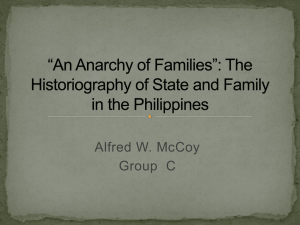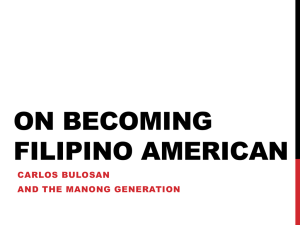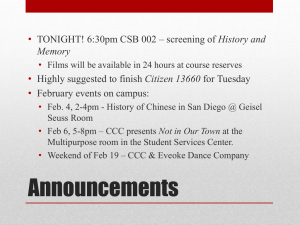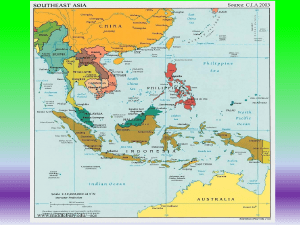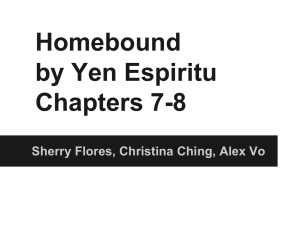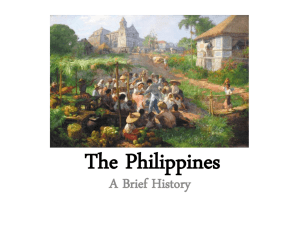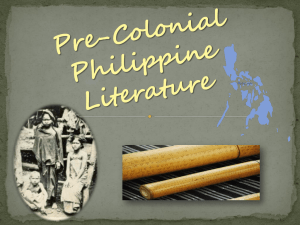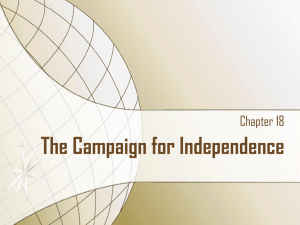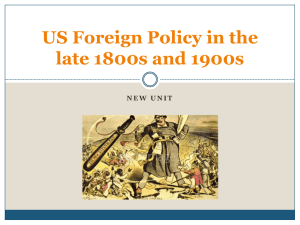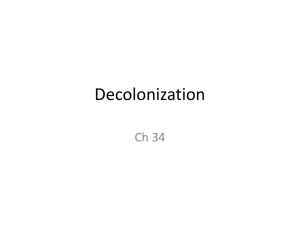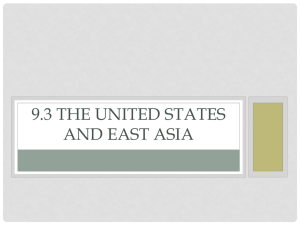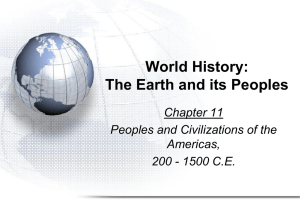american colony
advertisement
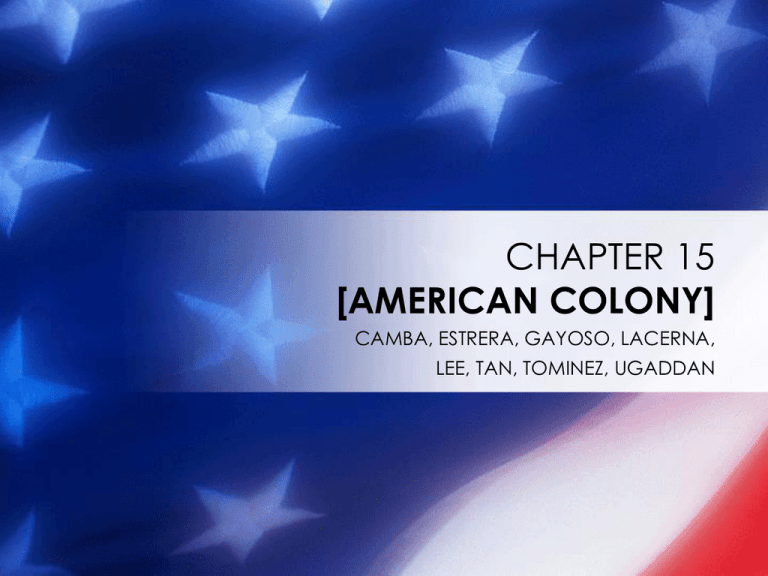
CHAPTER 15 [AMERICAN COLONY] CAMBA, ESTRERA, GAYOSO, LACERNA, LEE, TAN, TOMINEZ, UGADDAN THE CONTINUING RESISTANCE • The capture of General Emilio Aguinaldo at Palanan, Isabela in 1901.The Filipnino-American war ended. • The resistance can be conveniently seen in three sectoral perspectives: Christian, Muslim, and Tribal. THE KATIPUNAN INERTIA • After the Aguinaldo-led resistance ended, The inertia of the katipunan revolution that began from Bonifacio continued. • The remaining leader of the the Aguinaldo Army: General Miguel Malvar in Batangas, General Vicente Lukban in Samar, and other remaining officers continued the war in their respective areas. • The most prominent of the final efforts to continue the revolutionary struggle in Luzon was led by Macario Sakay, from 1902 to 1906 in Bulacan, Pampanga, Laguna, Nueva Ecija and Rizal. • Sakay was eventually persuaded by Dominador Gomez to yield. IN LUZON 1905 • The resistance was reported by the americans in the strategic areas of Luzon, Visayas, and Mindanao. • In Luzon in 1905, disturbance were reported in Cavite and Batangas. • Governer David Shanks of Cavite noted outbreaks at San Pedro Tunasan, Paranaque, Taal, and San Francisco de Malabon. • The leaders of the resistence were former officers of the revolutionary army who were respected by the people. • The conditions of the province led the resistance movement • By 1907, the mystification of the resistance had expressed itself in a strong mass movement led by Salvador Felipe. • He was known as “Apo Ipe” by his intimates. • His movement was called the Santa Iglesia Movement which means crusade of the “Holy Cross . • Salvador and his church gained a number of followers in the regions of Pampanga, Bulacan, Tarlac, and Nueva Ecija. • Weakening of the inertia by the year 1910, hv found a a short-lived outbreak in Nueva Ecija led by Simeon Mandac. • The policy of rapid filipinization initiated by Governor General Francis Burton Harrison in 1913. Led to the Filipino’s elite successful campaign to win Filipino masses. IN BICOL 1902 • One of the movements that worried the americans was led by Simeon Ola and about 1500 insurrectos (rebel) in Albay. • He was a hero of the Philippine Revolution and the last general to surrender to American forces during the Philippine-American War. • Col. Harry H. Bandholtz noted the significance role of Ola in the anti-colonial resistance, he regarded Ola as nothing but a ladron (thief) • Reconcentration System was the answer of the Americans to Ola’s movement. (March-October 1903) • The effect of the system was, inadequate food and accommodation’s to the people brought into the reconcentration area. Therefore, Diseases took their death toll and sufferings continued. • About 300,000 was estimated total casualities of the reconcentration system. • Governer Taft justify the method a “reign of terror” had been inaugurated by Ola in the province and other areas. • Negotiations were initiated by the authorities to persuade Ola to surrender. • Vice Governor Luke Wright and Dr.Trinidad Padro de Tavera went to Albay to help bring Ola to surrender to avoid the deployment of the U.S army. • September 22, 1903, Colonel Bandholtz signed an agreement with Ola Promising the latter immunity and other things” • By October, Ola finally surrendere, he felt it was better than the prospect of being confronted by the U.S troops that would be ordered to get him and his men. 500 to 600 of his followers joined the surrender. • Ola turned state witness against those who had joined him. • Ola was given thirsty yeas of prison for turning state witness. IN VISAYAS 1902 • SAMAR AND LEYTE – presented a serious challenge to the American Colony • “JETSAMS AND FLOTSAMS” – popular image of liberators and benefactors of the poor • BRIG. GEN. WILLIAM H. CARTER –reported that large portion of samarenos left their homes to join the bands (rebels). William H. Carter (IN VISAYAS) JULY 1904 • Tauiran affair -100 houses were burned, 21 people were killed • Cantaguic affair–the police lieutenant of the town and others were killed • Juliano Caducoy – (leader of the raiders) led the killing of the local teniente on command and the burning of american flag 1905 • Similar outbreaks in the island of Negros, Panay, Cebu, Leyte 1906 • Vice Gov. Henry C. Ide -ordered Gov. George Curry of Samar to persecute all the people who joined the “pulahan movement” • Pulahanes – name given to the insurrectos • March 24, 1906 – Taylor and Curry had an agreement with the pulahanes to surrender • Nasario Aguilar – (leader of pulahanes)attacked the constabulary garrison (IN VISAYAS) IN LEYTE 1906 • Jaime de Veyra – (governor of Leyte) is the most obnoxious anti-american leader in the archipelago • 1907 – American declaration of peace IN MINDANAO 1903 • William Howard Taft - reported that a group of “outlaws” entered the town of Surigao • and attacked the Constabulary under Capt. Clark. The captain was killed and the attackers • Mr. Luther S. Kelly – (provincial treasurer and indian scout of yellow stone) held the attackers while waiting for reinforcement • Murderers of Capt. Clark were captured and hanged. • Pres. Theodore Roosevelt commended Kelly for his heroic deed • Misamis (May 1903)- the resistance is unlike in Surigao because real insurrectos were part of the resistance. Panglima Hassan •siit- a secret landing of Wood’s campaign against Hassan. •Col. Hugh W. Scott- captured Hassan September 22, 1853 – April 30, 1934 • Jolo- is where Hassan was to be taken for imprisonment when he was captured. • Moro-patient intelligence -brought confirmed reports of Hassan’s location in the crater of Bud Bagsak. • Krises and Barungs- weapons used A Malay or Indonesian dagger with a wavy blade. known as kalis in the southern Philippines a thick, leaf-shaped, single-edged blade sword. It is a weapon used by Islamic tribes in the Southern Philippines. • 26- Bullet wounds sustained in Hassan’s body • Renegade Pala- followed the Panglima’s exploits after Hassan’s death -Authorities had been looking for him after a series of murderous robberies associated with him in Borneo. -Organized his own rebel band and defied American rule from 1905-1906. They were responsible for making the 1st American decade in Sulu: • Datu Usap • Paruka Utik • Salip Masdal • Maharaja Untung • Jikiri • Nakib Amir • Most significant emergence of armed conflicts: -Bud Bagsak Affair in 1913 -Jikiri Threat in 1909 Bud Dajo -located in the northern series of mountain ranges. • To confront the Muslims was a relatively small contingent of American troops composed of 65 men from the 6th Infantry, 65 men from the 4th Cavalry, and 130 soldiers from the 28th Mountain Battery. • Col. Hugh W. Scott of Zamboanga Constabulary and Captain John White - were ordered to procedd to Jolo with 50 men. • Prominent leaders of Patikul that were tapped as peace emissaries: -Datu Kalbi -Datu Julkanain -Panglima Bandahala • The battle began on March 5, 1906 and lasted up to the morning of March 8. • Colonel Duncan- was placed in command of the entire operation during the battle. • April 16, 1906- Wood held his last conciliatory conference with the datus and local leaders before turning over the governorship of the Moro Province to Gen. Tasker H. Bliss. Jikiri, 1907 • Jikiri– a native of jolo began his “piratical” attacks on trading vessels or villages early in the american period but he became notorious and known to media about 1907. • 1907-he had established a staging point in cabingaan island between the jolo and siasi island groups. • Jikiri’s notoriety was based not only on the killings of victims and the carting away of anything of value but also on his obsession to get beautiful women for his booty. • Jikiri’s obsession for beautiful maidens to some psychological problems caused or heightened by ugly facial features nature had given him since birth. • After long and tendious pursuit, reliable intelligence data were gathered by julius shuck’s people on the hideout of jikiri at patian island. (jikiri) • Jikiri was finally killed after a hand to hand combat liquidated the rest of his band. • With the death of jikiri’s, an irritating era of “piracy” came to an end and once again american rule had proven its successful campaign against recalcitrants in sulu. • 1909-marked the beginning of political change from the tasker bliss to the john pershing approach to the government or the affairs of the moro province. • Gen pershing assumed the governorship of the moro province and started a vigorous “disarmament campaign”in jolo. • The result was the revival of resistance which found tangible expression in the “battle of bud bagsak” Bud bagsak, 1913 • June 1912- loose firearms had been collected in jolo, except in lati and luuk where the opposition to disarmament was strong. • Panglima indanan- a powerful leader was arrested and disarmed, together with his aides and sons. • This was accompanied by the violent operations of the scouts in eastern part of the jolo, especially in lati where the sabilallah attacks on american troops became the source of colonial horror. • The number of defiant rebels was about 6000 to 10000, which include 10% combatants and warriors. • It appeared that the whole lati community was defiant against american rule under circumstances where the killings of non combatants was a grim reality. • The americans authorities appealed for non combatants and combatants to return to their abondoned farms and homes. • The non combatants were persuaded to avoid conflict and only the warriors remained determined to fight the colonial forces. Part of the compromise was the withdrawal of american troops from jolo island. • American intention was not to resort to final use of arms but rather to persuade them to surrender their fire arms for the sake of peace. • American strategy was to separate the noncombatants from the combatants. When this was achieved, pershing ordered immediate troop movements to bagsak which was reached by june 11, 1913. • The bud bagsak affair ended with pax americana dawning in sulu as over 500 rifles were gathered from the island. DATU ALI • DATU ALI Known as Raja Buayan, he was the ruler of the Upper Valley of Cotobato and was the acknowledged leader of the Maguindanaos in the 1900s. • He led the revolt against the American government from 1903 to 1906, first fighting the enemy in open battle, and then using guerrilla warfare. • His brother Djimbagan was captured at fort Serenaya and then used as hostage to force him to surrender, but he did not yield. He continued to fight until October, when in the Battle of Simpetan, he and most of his men were killed. In another battle later that month, three of his sons were also killed. DATU ALAMADA • DATU ALAMADA He continued Datu Ali's resistance to American rule in Cotobato after Ali's death in 1906. • With 300 men, he led attacks on American colonial forces in Buldon and Upper Cotobato, and commanded the loyal support of thousands of Muslims. • His influence was so strong that the Americans thought of hiring to destroy him. He refused to surrender to the Americans preferring to surrender to a Filipino official in 1913. Highlander Relations • The indigenous peoples of the Philippines consist of a large number of indigenous ethnic groups living in the country. They are the descendants of the original inhabitants of the Philippineswho have managed to resist centuries of Spanish and United States colonization and in the process have retained their customs and traditions. • In the 1990s, there were more than 100 highland tribal groups constituted approximately 3% of the population. The upland tribal groups were a blend in ethnic origin like other lowland Filipinos, although they did not have contact with the outside world. They displayed a variety of social organization, cultural expression and artistic skills. They showed a high degree of creativity, usually employed to embellish utilitarian objects, such as bowls, baskets, clothing, weapons and spoons. These groups ranged from various Igorot tribes, a group that includes the Bontoc, Ibaloi, Ifugao, Isneg, Kalinga, Kankana-ey and Tinguian, who built the Rice Terraces. They also covered a wide spectrum in terms of their integration and acculturation with lowland Christian and Muslim Filipinos. Native groups such as the Bukidnon in Mindanao, had intermarried with lowlanders for almost a century. Other groups such as the Kalinga in Luzon have remained isolated from lowland influence. • There were several indigenous groups living in the Cordillera Central of Luzon in 1990. At one time it was employed by lowland Filipinos in a pejorative sense, but in recent years it came to be used with pride by native groups in the mountain region as a positive expression of their ethnic identity. The Ifugaos of Ifugao Province, the Bontocs, Kalinga, Tinguian, the Kankana-ey and Ibaloiwere all farmers who constructed the rice terraces for many centuries. • Other mountain peoples of Luzon are the Isnegs of northern Kalinga-Apayao Province, the Gaddangs of the border between Kalinga-Apayao, and Isabela provinces and the Ilongots of Nueva Vizcaya Province and Caraballo Mountains all developed hunting and gathering, farming cultivation and headhunting. Other indigenous people such as the Negritos formerly dominated the highlands throughout the islands for thousands of years, but have been reduced to a small population, living in widely scattered locations, primarily along the eastern ranges of the mountains. • In the southern Philippines, upland and lowland tribal groups were concentrated on Mindanao and western Visayas, although there are several indigenous groups such as the Mangyan living inMindoro. Among the most important groups found on Mindanao are collectively called the Lumad, and includes the Manobo, Bukidnon of Bukidnon Province, Bagobo, Mandaya, and Mansaka, who inhabited the mountains bordering the Davao Gulf; the Subanon of upland areas in the Zamboanga; the Mamanua in the Agusan-Surigao border region; the Bilaan, Tiruray and Tboli in the region of the Cotabato province, and the Samal and Bajau in the Sulu Archipelago. The tribal groups of the Philippines are known for their carved wooden figures, baskets, weaving, pottery and weapons. Back to traditions • The Philippines has a tremendous number and variety of customs, traditions, fragments of old beliefs, fiestas, styles of dress both among the lowland Philippine people and the many tribal groupings. Here is a list of common Filipino traditions: Home/Structure: • Homeowner throws coins on housewarming day to bring luck. • Count the steps of the house; make sure it's not 13. This is "bilang Hudas" and it's bad luck. • Make sure the master bedroom is constructed so that it faces the east or has a window facing that direction. • Open the east window in the morning to let God's grace in. • Place some coins in the foundation of the cornerstone; or keep them below the master bedroom. However, don't put them by the doorstep or wealth will go away. • Avoid doors that look like thorough fares. • * When moving into a new home, see to it that rice is brought in first. • * Have your home blessed for safety and good fortune. • * Enthrone a statue of Christ the King; Sacred Heart of Jesus, and Immaculate Heart of Mary or have the statue of the Infant Jesus in the house. Make sure they face the door to greet your guests. • * Toss coins on house warming day for good luck. • * Friends coming to a new home must enter through the front doors. Weddings/Marriage/Childbearing: • Lovers must not give rosary or necklace to each other, if it breaks, the relationship might also get broken • * The bride or groom whose candle lasts longer will have a longer life to live. • * Bride: When the priest gives the signal "stand up or kneel down", make sure, you make the first move. This is so the husband does not completely rule over you. • * Never try on your wedding gown; it's a sign that the wedding may be cancelled. • * The Bride and groom shouldn't be traveling to distant places before the wedding; they are accident prone at this time. • "Sukob sa taon" (within same calendar year) marriages among brothers and sisters must be avoided. There will always be life competitions between the two couples. • * Don't ever turn down any offer to sponsor a baptismal, confirmation or wedding. It's a blessing. • * Don't mend or hem clothes while they are on your body if you don't want to bear a child without an anus. • * If a pregnant woman's stomach is rounded, she is likely to have a girl; if it's pointed, she's likely to have a boy. Moles & other beliefs: • A birth mark around the eye means you are appealing to guys. Other Beliefs: • * A birth mark on the chest means you are a true lover. • * Don't sweep the ground at dusk; the Virgin Mary is taking a walk and might catch the dust in her eyes. • * If someone has a mole on the sole of the foot, it means that person loves to walk all the time. • * If someone has a mole on his back, it means that the person wants to lie around and be plain lazy. • * A mole on the eyebrows means good luck in business. • * A mole on the palm means good luck. • * Never discard dirty, old clothes; wash them first. • * It's a bad luck to meet a black cat on a Friday morning. • * Breaking a mirror or glass is a bad omen. • * Having a disabled or handicapped child is your luck; caring for the child will give you more fortune. • * When you bit your lip/tongue, it means you're the subject of a conversation. Subanun Affair 1909 • On Nov. 1, 1909, Subanuns abandoned their homes & farms to head toward Mt. Dapeok & Malindang. This is because of the “call of the two boy prophets” who told them that the end of the world is coming. • The authorities were alarmed as it might be a trick by the Moros to deprive Subanuns of their valuables and harvest. • On Nov. 28, 1909, Captain Elarth together with his troops went to Dapeok in an attempt to stop the movement. • After several talks with the leaders of the group, the troops positioned nearby to persuade the people to abandon their activities. • But the Moros and Visayans started to agitate the Subanuns which caused thousands of them to attack the troops. • 6 constabulary, 1 policeman, & 4 cargadores were killed during the fight. The troops decided to withdrew and went back to their camps to avoid another attack. Literature of Resistance • A way or form of expressing resistance to the colonial government through literature. • Sedition Act of 1902 • A law that punishes anyone who makes any form of agitation or sedition through writing and drama plays. • Despite this Act of 1902, many writers still expressed resistance through literature. • Tagalog writers also expressed resistance through zarzuela which was a popular form of entertainment during the Spanish period. • Dramas were also effective during the American colonialism. • The literature of resistance was not only limited to dramatists and playwrights. Newsmen and journalists were also active in articulating the value of independence and the need for nationalism. CHAPTER 16 COMPROMISE WITH COLONIALISM COMPROMISE WITH COLONIALISM • The successful suppression of the various revolutionary outbreaks or disturbance following the formal end of the Filipino-American War. INVOLVEMENT DURING THE MILITARY PHASE 1899-1913 • The 1899, the Schurmann Comission, the first significant body created by President Mckinley, with Jacob Schurman, president of Cornell University. Initiated the non-military approach of American colonialism and succeeded. THE CHRISTIAN FILIPINOS IN THE LOCAL LEVEL • *A notable example of this readiness of the Filipino elite to collaborate was the case of the Negritos Island. This had early witnessed as early as 1898. • *Among the Negros elite who eventually became stalwart supporters of the American rule were Juan Araneta, Jose Lazuriaga,Leondro Locsin,Demetrio Larena, and Agustin Montilla. • *November 1898, they organized theirselves into a provisional government. • *February 1899, a committee of landowners from Negros were welcomed by the military government under General E. Otis. (THE CHRISTIAN FILIPINOS) • On March 1,1899 he created the Visayan Military district with General James F. Smith as of Governor of Negros. • The Shurman Comission organized municipal governements, starting in Baliwag, Bulacan. • *The Negrense Provincial Junta became its useful all in the American Countermeasures against the Malolos Government. • *In February 1899, the process of pacification was focused on the local government. • *Represented in Negros by Aguinaldo-appointed emissaries : Quintin Salas, and Zoilo Mauricio. • *And their masses led by their charismatic leader “Papa Islo” or Dionesio Magbuela in real life. • Attempts oby Aguinaldo to win the elite failed and the open conflict between the colonial forces and Malolos government erupted. • *Penetration of towns by American “peace feelers and agents” • *1901 the American colonial government could disclose the pacification of the islands and the establishment of the civil government. Except in the Muslim South where civil rule would not be formed until the abolition of the militarygoverned Moro Province in 1913. IN THE CENTRAL GOVERNMENT • Highly Centralized Government those few occupying the top Executive, Legislative, and Judicial exercised vast powers and influence in national affairs • The involvement of the Filipino elite was represented by those who are appointed as members of Philippine Comission. IN THE CENTRAL GOVERNMENT • Philippines had a highly centralized government composed of top executive, legislative, and judicial positions. • Filipino elites like Gregorio Araneta and Benito Legarda were appointed as members of the Phil. Commission • Cayetano Arellano, lawyer, professor of law in UST was appointed Chief Justice of the Supreme Court WHY THE ELITE? • American gov’t appointed only the Filipino Elites to occupy the position in the gov’t because of their readiness to accept colonialism THE CULTURAL COMMUNITIES • Americans were also successful in coopting the ruling elite at the start of American rule. In the tribal communities, American teachers and missionaries opened the path to an understanding of American benevolent policy through schools, religious missions, and especially, medical work. IN MINDANAO - It was a part of the American strategy to make the local datus and leaders to promote the need for social services. - The building of schools was undertaken with American supervision of native workers using existing materials. It was illustrated by Datu Santago of Cotabato and his men. - The same was true of the campaign against unsanitary living conditions and diseases that frequently led to epidemics like cholera, dysentery, smallpox and malaria - Local leaders, with only a few exceptions, helped by setting personal examples of hygiene and proper sanitation - Education of children was very much emphasized, especially those of the ruling class. - The schools of the Subanuns, the Tausugs in Sulu, and even a proposed Datu School in Zamboanga were to prepare ruling for active involevment in their own local areas. - The critical role of American teachers was underlined by the Governor of the Moro Province, Brig. Gen. John J. Pershing. He remarked: “ The school system depends for its success entirely upon the American teachers, and although Filipino teachers do excellent work under proper supervision, educational direction must for some time remain in the hands of the American teachers.” - One of the most effective instruments of American educational politics was Dr. Najeeb M. Saleeby, a medical practitioner turned educator. Dr. Najeeb M. Saleeby - He is a Christian Arab. - With education obtained from the American University in Beirut and a medical degree from New York’s Bellevue Medical School, gave him the kind of advantage to deal with the education of the Muslims in the Molo Province. - His knowledge of Arabic and Islam provided him with a personal touch that enabled him to win a lot of friends among the Muslim leaders, including those that were opposed to American rule like Datu Ali of Cotabato, the royalties of Cebu, and the datus of Lanao • His initial work as medical surgeon in Malabag, Lanao provided opportunities to win the Ilanuns, a Muslim sub-ethnic group. • - His appointment as School Superintendent for the District of Mindanao and Jolo on June 1, 1903, after a brief assignment as Assistant Chief of the Bureau of educational objectives in the Moro Province. In The Cordilleras •Cordilleras- where Americans were confronted by many problems of the FilipinoAmerican War which had brought retreating forces of 200 Filipinos under Aguinaldo to the traditionally hostile Ifugao country. • Sagbangan and Hapao- two conflict Ifugao groups •Humiwat- leader of an Ifugao band that beheaded an American soldier, surrendered and offered his cooperation in the American effort to establish a presence in the Cordilleras. • Dr. David P. Barrows- head of the Bureau of Non-Christian Tribes. • Secretary of the Interior Worcester- had gotten Dominga Atandada of Dullayan and Rafael Baluyunoan to accept American rule. • 92 chiefs and headmen of the Ifugao country answered the American call for a conference to organize a government in the Ifugao area. • Nagacaran Ifugaos- they were the only ones who resisted the offer and boycotted the meeting. • The pacification efforts of the Americans found very encouraging prospects in the pioneering activities of former military men like Samuel Kane and Al Hora whose business explorations and adventures provided later American officers and officials insights into Ifugao character and psychology. • Capt. Lewis Patstone and Lt. Levi Case- army officers who contributed a lot in preparing the Ifugaos for the eventual establishment of American political structures in the area, integrating not only the Ifugaos but also the other Igorots into the Constabulary as soldiers and into the local government as presidentes (mayors) or cabecillas. • Lt. Jeff D. Gallman- by the beginning of 1906, his entry into Ifugao country saw the beginning of an era of peace among the Ifugaos and American rule set pace and patterns for the rest of the Cordilleras. Treaty Traps • Bates Treaty- signed by Sultan Jamalul Kiram and Gen. John C. Bates on August 20, 1899. -Guaranteed peace between the Americans and Muslims in Sulu. -The Tausug version of this treaty clearly substantiates this view. While the English version clearly provides for the establishment of American rule in Sulu and the acceptance of American sovereignty by the Sultan and the datus. • English version of the treaty- allowed the Americans to interfere even in the resolution of disputes concerning matters related to slavery, taxes, peace and order, trade, commerce, foreign relations, except in the matters pertaining to religious practices and customs. • The conflict between the Sulu people and the American authorities creates an adverse situation that presaged the unilateral obligation of the treaty in March 1904 by the colonial government as expressed through Governor-General William Howard Taft and Moro Province Governor Leonard Wood. • Datu Kalbi and Datu Julkanain- signed the document, the Patikul political leadership which had been added to those who supported American rule. • Maimbung- the Sultanate’s political center -the flourishing trading point in the southern part of Jolo. • Patikul- center of activities in the northern part • Lanao and Cotabato- where Moro armed disturbances were effectively suppressed. - where the Americans demonstrated military technology • Hassan Revolt- was partly attributed by the Americans to the encouragement given by the Sultan. THE CARPENTER KIRAM AGREEMENT • The kiram –carpenter agreement (march 22, 1915)-the agreement divested the sultan of all his political power and prerogative. He was only allowed to exercise the rights and duties of a spiritual leader. • The agreement created problems for the sultan.it would be difficult to truly exercise spiritual influnce without the political authority the sultan previously enjoyed. • “note” preliminary to the main part of agreement These are: • Recognition of the independent sovereignty of the sultanate prior to american occupation • The recognition of the partial exercise of sovereignty of the sultanate by spain during the latter part of the spanish occupation of the philippines but only in relation to foreign affairs and to a lesser degree, ony on the port of jolo and four other points occupied by “spanish military garrisons” • The recognition ofa partial but de facto temporal sovereignty of the united states under the bates treaty, whose provisions in article ix allowed the united states to deal with cases of crimes and offenses “committed by moros against moros”. • There is, therefore, no doubt that with comprehensive provisions of the agreement, the beginning of the end sultanate was initiated, at the same time also the gradual rise of the filipino power over the moros would become a reality in subsequent political developments in moroland. • Increase in filipino participation • Political change in the united states • 1912-the poltical climate in the us had changed not only was a new president coming in woodrow wilson but a new political orientation was expected to emerge from the change to democratic rule. • The republican administration had been associated with the acquisition overseas colonies for the business or economic interest of american society. • The establishment of american colonies, including the philippines, was part of the expansionist inertia that came from the vigorous, westward expansion of the american colonist the vast frontiers of indian territories looking for new opportunites and lands until the pacific coast of california was reached. • The need for raw materials and markets added an econimic dimension to american territorial expansion just as the influence of the great comission brought in the religious vision of the fundamentalist of america to see the gospel message preached to the “regions beyond”. Effects on Colony • This was the start of the Democratic party administration after the Republican defeat. • In 1913, Francis Burton Harrison became the first Democratic Governor –General for the Philippines. American policies were implemented. • In the executive branch, there was a change from an American to a Filipino majority in the Philippine Commission in 1913 and in the Council of State and the Board of Control in 1918. • The Council of State was the advisory body of the Chief Executive while the Board of Control regulated government participation in business corporations and firms. • By 1913, the Civil service had become 70% Filipino. By the end of Harrison’s term in 1921, it had only about 6% Americans • Rapid Filipinization of the government was also evident in the legislative branch of the government. • Before 1916, legislation was still under dominant control of the Americans. Only the Philippine Assembly, which was cleared in 1907, was Filipino. • In 1916, the Jones Law was passed, and it was only during this time that the legislative power in the islands was given to the Filipinos. Only the veto power of the Chief Executive in the presidential system remained as the source of American control over legislation. • Under the Jones Law, a bicameral legislature was created. It is composed of a 24-member Senate as the upper house and a House of Representatives as the house chamber. All the members of the legislature were elected except the two senators from the non-Christian sector, who were appointed by the governor general • The Filipinos’ role in local administration from provincial to municipal level was strengthened. • The American influence in the position of provincial treasurer was held by the Americans. • Except for the general power of supervision,the municipal government was under Filipino control. • In 1899, The Supreme Court was created wherein Filipinos had substancial participation in the judiciary. • In 1901, Cayetano Arellano became Chief Justice. The lower courts had both American and Filipino judges, with increasingly growing number of Filipino judges. Limits to Filipinization Restraints of Elitism • Filipinization involved only the upper crust of Filipino society, those who belonged to the national and local elite. • Filipino members of the Philippine Commission were from the landlord and capitalist families, so were those in the choice positions in the Civil Service. Even the municipal level of the government was manned by elective officials who came from the local elite. Under the law, those who could run for office must be able to read and write, and must be property owners, or have been government employees during the Spanish period. So the election law already limited participation to the elite. • The Americans saw the natural inclination of the elite to the colonial power. The interest of the elite were compatible with those of colonialism and the Americans were ready to give them significant share of power, wealth, and status in the islands. Aside from that, their rights to new access to external power was recognized. Therefore, a lot of practical advantages were given to the elite from the American colonial government compared to the almost nil offerings under Spanish rule. • That had lead to the Filipino elite’s cooperation and loyalty to the United States. • That was also the basis of American readiness to give more and more to Filipinos the administration of the bureaucracy except the highest executive post in the islands, the position of Secretary of Public Instruction, and The National Treasury, The BIR, Bureau of Customs and the local treasuries. • Thus Filipinization, as implemented by the Democratic administration, fitted into overall scheme of colonial rule. Economic Limitation • The dilemma of Filipino leadership was best seen in the economic relations with the United States during the Harrison era (1913-1920). Before this period, the economic policy of the United States was anchored entirely on the ambiguities of the Paris Treaty of 1898 and later, on the “free trade” provisions of the Payne-Aldrich Tariff act of 1909. Until 1909, American economic interests would be affected by the most-favored-nation treatment given to Spain for a period of ten years under the Treaty of Paris, thus preventing the enactment of any trade policy favorable to American economic interests. The end of the ten-year privilege in 1909 gave the United Stated the first opportunity to initiate what became popularly known as “Free Trade”. This was a unique kind of relation because the exercise of freedom by the United States and the Philippines was not equal. The freedom of Filipino interests was limited by a quota system while that of American interests was absolutely free. The limitation to Filipino economic interests involved the volume and kind of export, while no similar restriction was placed on American interests • Consequently, the Philippines became an exclusive American market with American goods literally moving into the colony without limitation. But Philippine exports to the American market were governed by quotas and limited only to raw materials needed by American business. Thus, as relations of economic dependency became the pattern of Philippine relations with the United States, conversely, American control of the Philippine economy, and consequently, Philippine leadership, was firmly established by the time the Underwood-Simmons Tariff Act was enacted in 1913 abolishing the quotas on Philippine exports • There was, therefore, “free trade” literally between the Philippines and the US during Harrison’s term and beyond until 1943 when quotas were reimposed by the Tydings-McDuffie Law. It was during this liberal trade policy that the partnership between Filipino and American economic interests was strengthened by the dependence of Filipino landowning class on lucrative American markets for their agricultural exports. This economic dependence would continue to be reinforced through the years and the role of the Filipino elite would also be inextricably tied with the preservation of American rights and privileges not only in the economic area but also the political, social, and cultural fields. Tradition Vs. Modernism • The establishment of American liberal democracy as the new pattern of the Filipino way of life would bring about the confrontation between Filipino traditional ways and the new system. This new system would create a dichotomy of systems in which democratic form & a traditional essence were welded to create “democracy Filipino style” • The Filipino elite were no longer viewed as “collaborators” but “partners” in the new democratic system. • The new democratic system involves: free education, health, & sanitation, public works & transportation, various employment opportunities, and ready markets for agriculture products. Democracy Filipino Style • Before the end of Harrison’s term, the American colonial noticed that the essence of democracy had yet to be developed due to the continuous manifestation of the Filipino values in the actual operation of the new democracy. Which they considered as counterproductive to the new democracy. • The Americans failed to see is that the Filipinos saw no contradiction between the new democratic institutions and traditional practices. • Ritual kinship such as pakikisama, utan na loob, and other values preserved harmony in the native society. • Charges of Filipino incompetence in the bureaucracy, graft and corruption, and the unpreparedness of the Filipinos for independence became the basis of criticism against the administration of Gov. Francis Burton Harrison. • Despite this criticisms the Filipinos considered his term the best because it was a demonstration of what trust could do to FilipinoAmerican relations. CHAPTER 17 COLONIAL POLITICS: TOWARDS COMPLETE AUTONOMY Wood-Forbes Mission: • Wood–Forbes Mission, (1921), fact-finding commission sent to the Philippines by newly elected U.S. president Warren Harding in March 1921, which concluded that Filipinos were not yet ready for independence from the United States. • In 1913 Woodrow Wilson had appointed the liberal Francis B. Harrison as governor general of the Philippines. Harrison was convinced that the best method of preparing Filipinos for independence was to give them as wide a latitude as possible in managing their internal affairs. Passage of the Jones Act in 1916, which announced the U.S. intention of granting Philippine independence, encouraged Harrison in his policy of replacing Americans in the Philippine civil service with Filipinos. • Republicans in the United States argued that Harrison’s policy of Filipinization was premature and that the takeover of jobs by Filipinos resulted only in a marked deterioration of services. To support this position, Harding sent out Gen. Leonard Wood and W. Cameron Forbes. The two reported in October 1921 that the islands were not prepared for independence and that many educated Filipinos wished to remain under American tutelage. • News of the Wood–Forbes report was received with anger in the Philippines. Wood, who served as governor general for the next six years, though an honest and efficient administrator, remained highly unpopular with Filipinos. THE ADMINISTRATION OF LEONARD WOOD (1921-1912) • The choice of Leonard Wood as a GovernerGeneral demonstrate that the President Harding accepted the Wood-Forbes Mission’s recommendations as to Philippine policy. • *The administration of Governer Wood was marked by vigourous political agitation- the most intense Philippine-American relations since the end of the Filipino-American War. • *He took the position that the Jones Law- organic act operating in the Philippines. Could not be modified except by action of the US Congress itself. WOOD V.S. FILIPINO POLITICOS • JULY 17, 1923 – Gov. Wood’s filipino cabinet members resigned, due to “cabinet crisis” • Filipinos hated Gov. Wood, they regarded him an enemy of Philippine autonomy and independence. • 1922 –Quezon was having trouble in assuring his ascendancy among his followers and political rivals within the Nacionalista Party. • Quezon reconciled with Osmena’s nationalistas inorder to dominate the legislature. A move which his followers considered an outrageous betrayal of people’s trust • Gov. Wood got himself caught in the web of filipino partisan politics combined with the highly emotional issue of independence The Conley Case & Cabinet Crisis • Wood’s action on a police matter known as the Conley Case provided Quezon with an issue, and he used it to bring on the “Cabinet Crisis”. • By engineering this crisis, Quezon succeeded in electrifying an electorate which promptly supported the Quezon-Osmena coalition. • Conley case is a controversy over charges of misconduct in office filed against an American named Ray Conley who was the chief of the vice squad of the Secret Service branch of the Manila Police Dept. The Veto Power of Governor Wood • In the eyes of the Filipino leaders, was being excessively exercised, “on the most flimsy motives” • Showed the following: From October 1923 to February 1924, the Sixth Philippine Legislature passed 217 bills and concurrent resolutions, out of which 46 were vetoed. • In the first session of the Seventh Legislature in 1925, 24 out of 72 bills were vetoed, and in the second session in 1926, the Legislature passed 122 bills, out of which 44 were vetoed. • Harrison only vetoed 5 measures in 7 years in office. - The Governor did not only liberally his power to veto bills passed by the Legislature, but he even went to the extend of altering measures already passed by the Legislature, and then affixing his signature after the alteration made. - The Filipino leaders were also annoyed that Wood should veto bills of local interest and insisted that before the Governor-General acted unfavorably on any bill, their views must first be heard. - Wood explained that they are due to serious defects or unconstitutional provisions. This unsatisfactory condition was largely due to the rushing through a large number of bills during the last hours of session, without opportunity being given for their careful consideration. - Wood was convinced that the Filipino leaders deliberately showered him with impracticable legislation to draw his vetoes and thus give him fresh opportunity to charge him with “despotism” The Board of Control Controversy • Wood was convinced that the Board was illegal because the Governor-General occupied a minority position in it, and so he could never get the consent of the two Filipino members(the Senate President and the House Speaker) to get the government out of business. • Two fundamental reasons advanced by Wood for getting the government out of business: first, the Philippine treasury needed the money invested in the business enterprises to spend it for the greater benefit of the public; second, the governments were not qualified, in any nation of the world, to conduct business or engage in any industries which would compete with private initiative Leonard Wood: in Retrospect • Filipino politicos- led by Quezon openly challenging the authority of the American representative in Manila. • Harrison-any Governor-General who was sent to the Phil. After him would have found the Filipino leaders particularly difficult to handle, unless they went as far as he did in allowing the Filipinos a generous share in the direction of their affairs. • 1923- Wood governed the Philippines without any serious disruptions to governmental functions. The administration of henry l. Stimson: cooperation restored • The administration of henry l. Stimson: cooperation restored • Henry l. Stimson –was inaugurated governor-general of the philippines on march 1, 1928. • He seemed better able to understand the uses of power in dealing with dependent people. • He was firm in asserting his rights as chief executive. • Expressing his view that only that would “save the islands from the danger of immediate independence”. • He sympathized with the filipino demand for more responsibility. • Stimson had only one year in the philippines this year was generally characterized by very cordial relations between the filpinos and american elements in government and society. • The first complete cabinet since july 1923 was named. • Stimson also established a “new era” for the philippines by a change of emphasis as to the prerequisites for independence. • At the end of his year’s experience in the philippines stimson was pleased at the “general mental change”. • He had discerned among the filipino leaders who had begun to consider the “economic foundations of their political problems”. • The most significant achivement of stimson’s year in the philippines was “the cessation of the period of acrimonious deadlock” and friendly feelings between the american authority and filipino leadership • He was able to accomplish because he understoof what was necessary in order that the sensitive filipinos would not be “provoked into fanatical outbursts”
